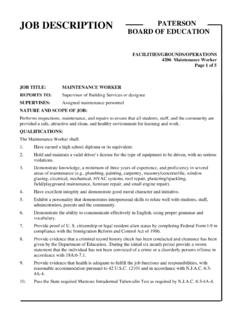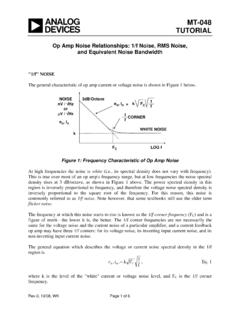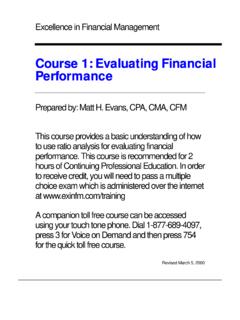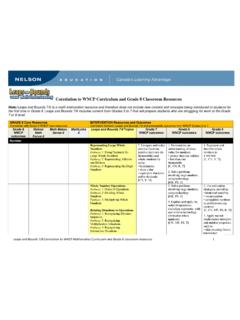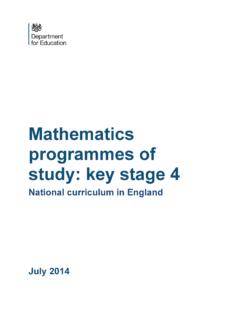Transcription of Mathematics Pacing - paterson.k12.nj.us
1 Mathematics Pacing Grade: 7 Pre-Algebra UNIT: # 2 Instruction: 11/13/18 1/18/19 Assessment: 1/22/19 1/25/19 Equations, Inequalities, & Proportions 8/13/2018 # STUDENT LEARNING OBJECTIVES NJSLS Resources 1 Use variables to represent quantities in a real-world or mathematical problem by constructing simple equations and inequalities to represent problems. , 4b* IFL Investigating Inequalities. 2 Fluently solve equations; solve inequalities, graph the solution set of the inequality and interpret the solutions in the context of the problem (Equations of the form px + q = r and p(x + q) = r and inequalities of the form px + q > r, px + q r, px+ q r, or px + q < r, where p, q, and r are specific rational numbers).
2 , 4b* 3 Apply the distributive property and collect like terms to solve linear equations in one variable that contain rational numbers as coefficients. Use an equivalent equation of the form x = a, a = a, or a = b (where a and b are different numbers) to describe the number of solutions. , 7b IFL Equations and Linear Functions: Solving Linear Equations in One Variable. 4 Calculate and interpret unit rates of various quantities involving ratios of fractions that contain like and different units. IFL Proportional Relationships." IFL Proportional Relationships." 5 Determine if a proportional relationship exists between two quantities by testing for equivalent ratios in a table or graph on the coordinate plane and observing whether the graph is a straight line through the origin.
3 6 Identify the constant of proportionality (unit rate) from tables, graphs, equations, diagrams, and verbal descriptions. 7 Write equations to model proportional relationships in real world problems. Mathematics Pacing Grade: 7 Pre-Algebra UNIT: # 2 Instruction: 11/13/18 1/18/19 Assessment: 1/22/19 1/25/19 Equations, Inequalities, & Proportions 8/13/2018 Key: Major Clusters Supporting Additional Clusters * Benchmarked Standard 8 Use the graph of a proportional relationship to interpret the meaning of any point (x, y) on the graph in terms of the situation - including the points (0, 0) and (1, r), recognizing that r is the unit rate. 9 Solve multi-step ratio and percent problems using proportional relationships (simple interest, tax, markups and markdowns, gratuities and commissions, fees, percent increase and decrease, percent error).
4 * 10 Graph proportional relationships, interpreting slope as unit rate, and compare two proportional relationships, each represented in different ways. 11 Solve problems involving scale drawings of geometric figures, including computing actual lengths and areas from a scale drawing and reproducing a scale drawing at a different scale. * 12 Use freehand, mechanical ( ruler, protractor) and technological tools to draw geometric shapes with given conditions ( scale factor), focusing on constructing triangles. 13 Give informal arguments to justify facts about the exterior angles of a triangle, the sum of the measures of the interior angles of a triangle, the angle-angle relationship used to determine similar triangles, and the angles created when parallel lines are cut by a transversal.
5 14 Write and solve simple multi-step algebraic equations involving supplementary, complementary, vertical, and adjacent angles. * Mathematics Pacing Grade: 7 Pre-Algebra UNIT: # 2 Instruction: 11/13/18 1/18/19 Assessment: 1/22/19 1/25/19 Equations, Inequalities, & Proportions 8/13/2018 Code # New Jersey Student Learning Standards * Use variables to represent quantities in a real-world or mathematical problem, and construct simple equations and inequalities to solve problems by reasoning about the quantities. *(benchmarked) a) Solve word problems leading to equations of the form px + q = r and p(x + q) = r, where p, q, and r are specific rational numbers. Solve equations of these forms fluently.
6 Compare an algebraic solution to an arithmetic solution, identifying the sequence of the operations used in each approach. For example, the perimeter of a rectangle is 54 cm. Its length is 6 cm. What is its width? b) Solve word problems leading to inequalities of the form px + q > r or px + q < r, where p, q, and r are specific rational numbers. Graph the solution set of the inequality and interpret it in the context of the problem. For example: As a salesperson, you are paid $50 per week plus $3 per sale. This week you want your pay to be at least $100. Write an inequality for the number of sales you need to make, and describe the solutions. *(benchmarked) Solve linear equations in one variable.
7 A) Give examples of linear equations in one variable with one solution, infinitely many solutions, or no solutions. Show which of these possibilities is the case by successively transforming the given equation into simpler forms, until an equivalent equation of the form x = a, a = a, or a = b results (where a and b are different numbers). b) Solve linear equations with rational number coefficients, including equations whose solutions require Mathematics Pacing Grade: 7 Pre-Algebra UNIT: # 2 Instruction: 11/13/18 1/18/19 Assessment: 1/22/19 1/25/19 Equations, Inequalities, & Proportions 8/13/2018 expanding expressions using the distributive property and collecting like terms. Compute unit rates associated with ratios of fractions, including ratios of lengths, areas and other quantities measured in like or different units.
8 For example, if a person walks 1/2 mile in each 1/4 hour, compute the unit rate as the complex fraction 4121 mph, equivalently 2 mph. Use facts about supplementary, complementary, vertical, and adjacent angles in a multi-step problem to write and solve simple equations for an unknown angle in a figure. Recognize and represent proportional relationships between quantities. a) Decide whether two quantities are in a proportional relationship, , by testing for equivalent ratios in a table or graphing on a coordinate plane and observing whether the graph is a straight line through the origin. b) Identify the constant of proportionality (unit rate) in tables, graphs, equations, diagrams, and verbal descriptions of proportional relationships.
9 C). Represent proportional relationships by equations. For example, if total cost t is proportional to the number n of items purchased at a constant price p, the relationship between the total cost and the number of items can be expressed as t = pn. d) Explain what a point (x, y) on the graph of a proportional relationship means in terms of the situation, with special attention to the points (0, 0) and (1, r) where r is the unit rate. Solve problems involving scale drawings of geometric figures, including computing actual lengths and areas from a scale drawing and reproducing a scale drawing at a different scale. Mathematics Pacing Grade: 7 Pre-Algebra UNIT: # 2 Instruction: 11/13/18 1/18/19 Assessment: 1/22/19 1/25/19 Equations, Inequalities, & Proportions 8/13/2018 * Use proportional relationships to solve multistep ratio and percent problems.
10 Examples: simple interest, tax, markups and markdowns, gratuities and commissions, fees, percent increase and decrease, percent error. *(benchmarked) Draw (with technology, with ruler and protractor as well as freehand) geometric shapes with given conditions. Focus on constructing triangles from three measures of angles or sides, noticing when the conditions determine a unique triangle, more than one triangle, or no triangle. Graph proportional relationships, interpreting the unit rate as the slope of the graph. Compare two different proportional relationships represented in different ways. For example, compare a distance-time graph to a distance-time equation to determine which of two moving objects has greater speed.







